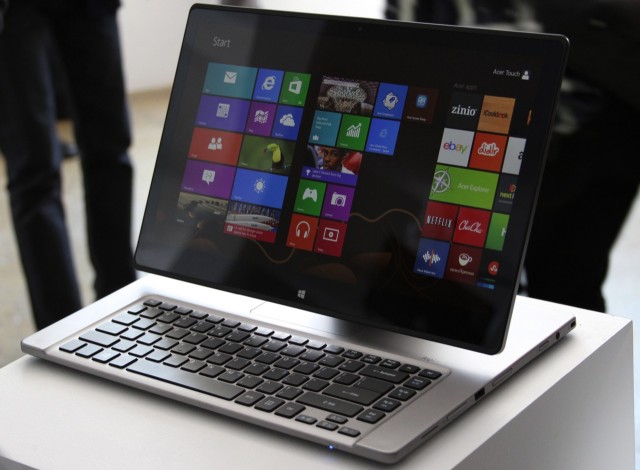
Acer's Aspire R7 is the latest in a long line of experimental Windows 8 PCs.
Whatever your feelings about Windows 8, there's no question that it (along with external threats from devices like tablets) has spurred PC makers to get more inventive than they've been in years. Not all of the convertible laptops built for the new operating system have been home runs, but after years of seeing the same designs get slightly thinner and slightly cheaper with every new iteration, the form has given PC OEMs some real opportunities to differentiate themselves.
We're going to start seeing the second wave of these systems over the next few months and if they're anything like what Acer unveiled this morning at a New York City event, well, they're certainly still going to be interesting.
The Acer Aspire R7
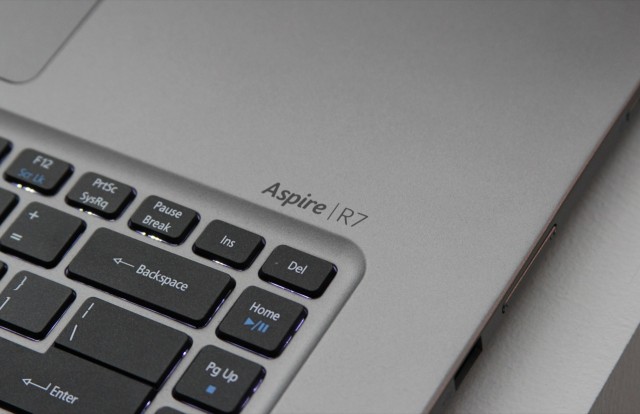
The Aspire R7, a sort of spiritual sibling to the earlier Aspire S7.
Andrew Cunningham
I don't think I'm exaggerating when I say that Acer's Aspire R7 is the strangest Windows 8 laptop I've seen yet. Two things make it interesting: first, its 15.6-inch, 1080p touchscreen is mounted on a stand called an "Ezel" (pronounced "easel") that allows you to tilt the screen, flip it over to show something to a person in front of you, or fold it down over the keyboard and trackpad. Second, it swaps the traditional positions of the keyboard and trackpad, putting the trackpad nearer to the monitor and moving the keyboard nearer to the user.
The R7 has apparently been designed "with an approach that's based on how people interact with their notebooks and other devices,” says Acer America marketing vice president Sumit Agnihotry. By allowing the user to move the touchscreen into pretty much any position, the laptop theoretically makes it less inconvenient for the user to reach out and touch things if they're typing or using the trackpad. The hinge itself is very flexible and very stiff, and while it is usually going to require two hands to manipulate, you don't need to worry about moving the screen without meaning to. It also sits flush with the lid of the device when the laptop is closed, so it doesn't take up any more space than a more conventional 15-inch laptop (though it does look a bit odd).

No, you're not tripping: the R7 reverses the conventional positioning of the keyboard and trackpad.

A clear shot of the "Ezel" hinge. Here, the screen is flipped all the way over to show the person across from you what's on the display; Windows 8 automatically flips the display based on the screen's physical position.
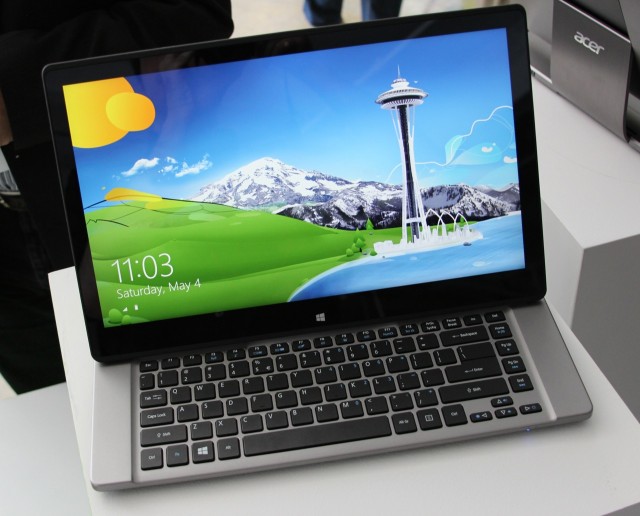
The screen can be brought closer to the keyboard, making it theoretically less onerous to interrupt your typing to touch something.

As stiff as the hinge is, it's also very flexible, and can bend into lots of other positions. When you fold the screen down over the keyboard and trackpad, it doesn't sit flush, but is angled slightly toward the user.
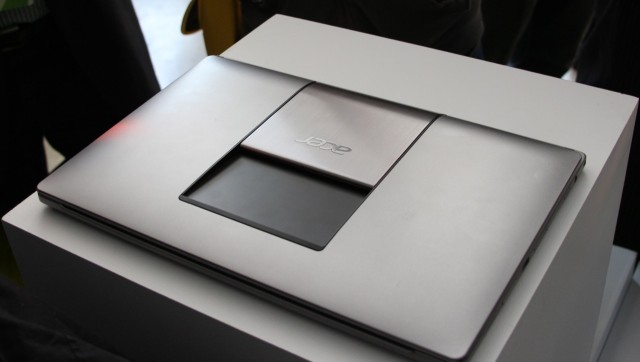 Close the laptop, and the Ezel hinge sits flush against the lid.
Close the laptop, and the Ezel hinge sits flush against the lid.
It's difficult to evaluate just how the switched trackpad and keyboard positioning will actually impact the way you use the computer. When the computer is on a desk or table, the typing experience is actually very desktop-like—you can rest your wrists on the table, or on whatever wrist pad you happen to prefer. When the laptop is actually in your lap, though, typing is more awkward. You're left to either rest your wrists on your lap, which in addition to being a bit awkward increases the amount of lap space you'll need to use the laptop; or to let your wrists float in the air as you type, which isn't very comfortable for more than a couple of minutes. I would want to use the laptop for at least a few days to see how I'd adapt to this kind of keyboard, but it was probably the thing I liked the least about the computer in the 15-or-so minutes I spent with it.
The keyboard itself is a step up from past Acer keyboards in quality and layout—the lightly-textured plastic keys have good travel and a nice, even backlight, two things we couldn't say about the disappointing keyboard on the Acer Aspire S7. We had a little difficulty consistently activating the Windows 8 trackpad gestures, but it otherwise seemed pretty responsive. The overall build quality is generally excellent, and it's nice to see Acer making continued improvements on this front.

In general, the laptop's aluminum body feels like another step forward in build quality for Acer.
On the inside, the computer is the same as any Ultrabook—the demo unit was running a 1.8GHz Intel Core i5-3337U based on Intel's Ivy Bridge architecture, along with its integrated HD 4000 GPU (though dedicated Nvidia graphics will reportedly also be available). It's too bad that these systems couldn't wait for Intel's next-generation Haswell parts, especially since they'll be delivering anothersizable boost in graphics performance—we're at the tail end of Ivy Bridge's reign, and while it's by no means a bad performer it's a little difficult to justify dropping over $1000 on a new PC when next-generation CPUs are right around the corner.
The Acer Aspire P3

The Acer Aspire P3 Ultrabook, which is less an Ultrabook than a thin tablet in a keyboard dock.
We also spent some time with a second new Ultrabook, the Aspire P3, but in this case the label is a little misleading. The computer is actually a revised version of the Iconia W700 tablet released last year, but when placed in its keyboard dock-turned-carrying case, it apparently meets the standards for Intel's Ultrabook label.
The dock itself has a nice-looking faux leather cover, though the Bluetooth keyboard itself shares its odd layout and lack of key travel with the keyboard on the Aspire S7. It also lacks any sort of pointing device, so you'll either need to bring your own Bluetooth mouse or use the touchscreen to interact with the OS.

The dock without the tablet in it. The keyboard, unfortunately, appears to be the same one used in the Aspire S7.

The dock also doubles as a faux-leather carrying case, and is quite thin.
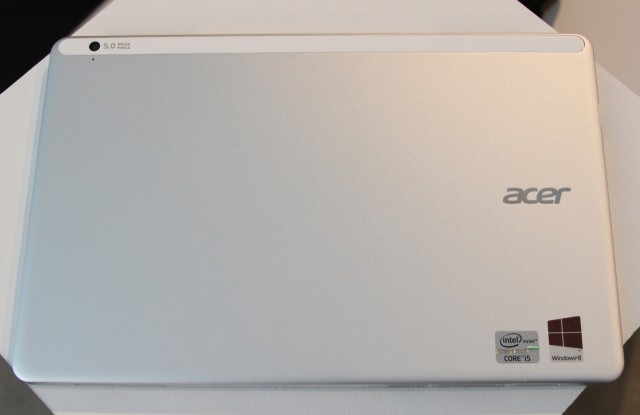
The tablet's back. The styling is very reminiscent of the earlier Aspire W700.
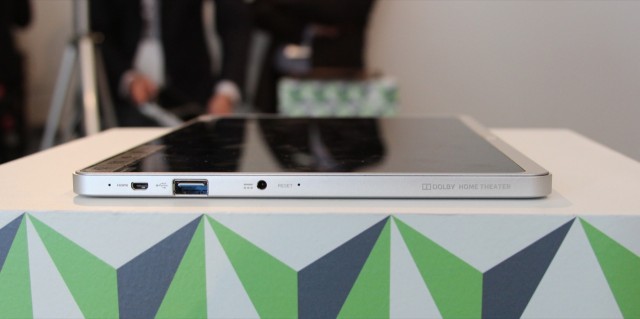
Enlarge / It shares the same port layout...
Andrew Cunningham

..and it also still needs fan vents.
The tablet uses Intel's new low-power Y-series Ivy Bridge processors, which are a bit slower than the U-series chips in the W700 and most Ultrabooks. They're still much quicker than ARM and Atom processors, though, and the power savings allowed Acer to make the P3 thinner and lighter than the W700 (1.75 pounds and 0.39" thick without the dock, compared to 2.1 pounds and 0.5" thick) while still maintaining what an Acer rep told me was approximately the same battery life. With the dock, the P3 is 3.06 pounds and 0.77" thick. It's still not as thin or light as an Atom or ARM tablet (and it still needs fans for cooling), but it's a nice step forward from the W700.
Unfortunately, it also takes a few other steps down from the W700: its 11.6-inch IPS display is now 1366×768 rather than 1920×1080, and the base model comes with 2GB of RAM instead of 4GB (though 4GB is still an option). These lowered specs will lower the cost of the tablet-turned-Ultrabook to $799 from the W700's $999, though at the expense of some desirable features.
The Aspire R7 will be available exclusively at Best Buy and starts at $999. Pre-orders can now be placed online, and the laptop will also be available in stores on May 17. The Acer Aspire P3 is available today, and isn't exclusive to any particular retailer. The company also unveiled a few other products, including a midrange 7.9-inch Android tablet called the Iconia A1; and low-to-mid-end 11-inch, 14-inch, and 15-inch V-series laptops. We've uploaded the full specs for all of these computers
No comments:
Post a Comment
Let us know your Thoughts and ideas!
Your comment will be deleted if you
Spam , Adv. Or use of bad language!
Try not to! And thank for visiting and for the comment
Keep visiting and spread and share our post !!
Sharing is a kind way of caring!! Thanks again!